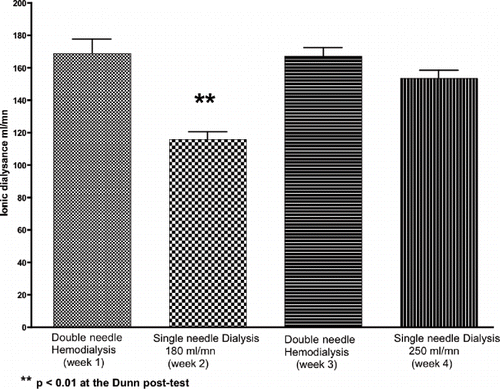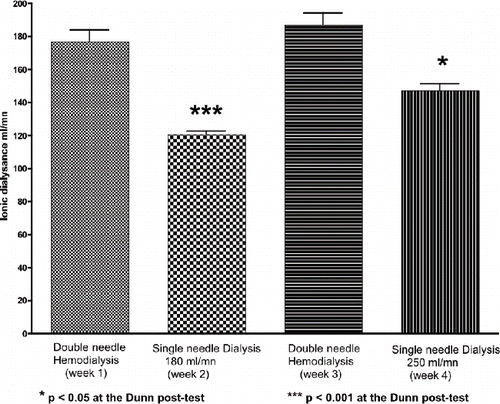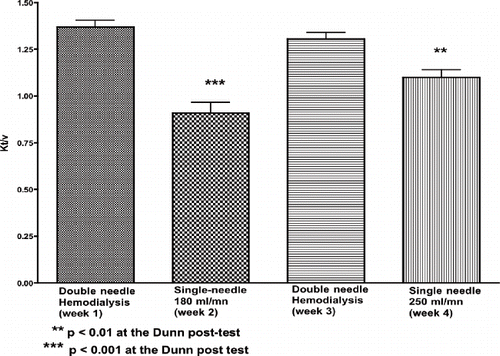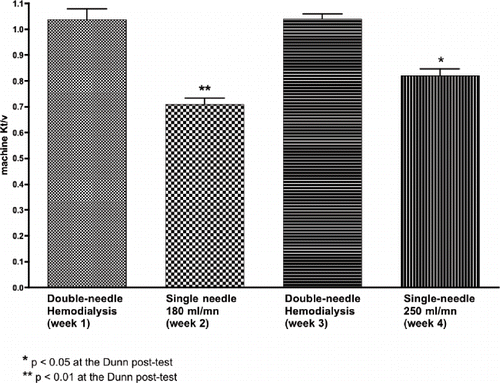Abstract
It is widely believed that single-needle (SN) hemodialysis is inferior to conventional double-needle (DN) hemodialysis. The purpose of this study was to compare two SN dialysis regimens using different blood flow rates with conventional DN hemodialysis. The primary outcome measure was ionic dialysance. We studied eight patients (two women, six men) undergoing chronic intermittent DN bicarbonate hemodialysis three times per week on a Cimino-Brescia fistula for at least three months. The study had a prospective four-period design and lasted four weeks. During weeks 1 and 3, the participants had standard DN hemodialysis sessions, with Wallace needles at a blood flow rate of 250–300 mL/min. During week 2, they had single-needle dialysis sessions with a short 15-gauge stainless-steel needle, an effective blood flow rate of 180 mL/min (360 mL/min for each of the two pumps), and venous pressure below 200 mmHg. During week 4, they had SN dialysis sessions with a short 15-gauge stainless-steel needle, an effective blood flow rate of 250 mL/min (500 mL/min for each of the two pumps), and a venous pressure below 200 mmHg. Ionic dialysance recorded 45 minutes after the beginning of the dialysis session and 30 minutes before the end of the session were used for statistical analysis. The effective blood flow target of 250 mL/min was achieved in six of the eight patients. Ionic dialysance 45 minutes after the beginning of the session differed among the four periods (p < 0.001, Friedman test). Ionic dialysance was better during each DN dialysis period than during the 180 mL/min SN period (p < 0.01, Dunn's multiple comparison tests), but there was no difference with the 250 mL/min SN period. Ionic dialysance 30 minutes before the end of the dialysis session differed among the four periods (p < 0.001, Friedman test). Ionic dialysance was far better during each DN period than during the 180 mL/min SN period (p < 0.001, Dunn's multiple comparison test) and slightly better than during the 250 mL/min SN period (p < 0.05, Dunn's multiple comparison test). The single-pool Kt/V ratio differed among the four periods (p < 0.0001, Friedman test). The Kt/V ratios were far better during each DN period than during the 180 mL/min SN period (p < 0.001, Dunn's multiple comparison test) and slightly better than during the 250 mL/min SN period (p < 0.01, Dunn's multiple comparison test). The Kt/v provided by the dialysis monitor gave identical results to single pool Kt/v. We conclude that single-needle dialysis with an effective blood flow rate of 180 mL/min delivers an inadequate dialysis dose, which may be harmful. In contrast, an effective blood flow rate of 250 mL/min appears acceptable for brief periods of single-needle dialysis lasting one or two weeks. Otherwise, an increase in the length of the dialysis session and/or the use of a larger membrane surface area and even higher blood flow is required to obtain the same quality of dialysis as with conventional double-needle hemodialysis. Careful monitoring of the dialysis dose delivered is mandatory during single-needle dialysis.
INTRODUCTION
Single-needle (SN) dialysis was first described in 1964 by Twiss, who used a time-activated mechanism with a pump and a double clamp to alternate blood through a caval catheter.[Citation1] In the 1980s, Belgian researchers using a specific canula and a twin pump-head SN system showed that dialysis efficiency was at least as good as with conventional DN hemodialysis, based on Kt/V, the hematocrit, and nerve conduction.[Citation2] They also showed that the five-year fistula survival rate was 74%, a figure far better than with conventional DN hemodialysis.[Citation3] SN dialysis failed to gain popularity, however, with the exception of Benelux countries, and has been confined to specific situations, such as the use of a single-lumen catheter and when temporary and reversible problems of vascular access arise.[Citation4,Citation[5]] The poor efficiency of SN dialysis is due to limited blood flow, a high recirculation rate (sometimes up to 54%) that is minimized by maximizing the inflow phase volume,[Citation6] and a shortened treatment time (due to biphasic circulation), although the latter has been improved by the use of a double-pump system.[Citation4–8] Moreover, SN dialysis might lead to an overestimation of Kt/V.[Citation8] Therefore, many nephrologists are reluctant to use SN dialysis, even in case of problematic vascular access.[Citation5] A preliminary study has recently shown that the dialysis dose during SN dialysis, reliably assessed by ionic dialysance, can be improved by increasing the blood flow rate.[Citation9] The purpose of the present study was to compare two SN dialysis regimens using different blood flow rates with conventional DN hemodialysis. The primary outcome measure was the adequacy of dialysis, based on ionic dialysance.[Citation10]
METHODS
Patients and Dialysis Techniques
The study was approved by the local ethics committee, and the patients gave their informed consent before entering the study. Eight patients (two women and six men) undergoing chronic intermittent bicarbonate double-needle hemodialysis three times per week on a Cimino-Brescia fistula for at least three months were included. Eligible patients were defined as follows: age more than 20 years, creatinine clearance less than 5 mL/min, stable adequate dry weight, ambulatory care, adequate access blood flow with a native arteriovenous fistula, blood flow at least 200 mL/min in DN hemodialysis, and patency (lack of stenosis) shown by echo-Doppler. The exclusion criterion were inadequate blood flow through the fistula, stenosis of the fistula or fistula angioplasty in the previous three months, access recirculation exceeding 15% (assessed by transonic), obesity (BMI > 30), hemodynamic instability during dialysis sessions, a phosphorus level above 3 mmol/L, and concurrent severe illness.
The median age was 69 years (range 62–85 years), and the median time on hemodialysis was three years (range 1–5 years). summarizes the characteristics of the patients. Dialysis sessions were performed without dialyzer reuse, which is forbidden in France. Dry weight was estimated by echography of the inferior vena cava, echocardiographic estimation of end-diastolic left ventricular size two hours after a dialysis session (or the morning after an evening dialysis session), and clinical evaluation. All the patients were at their optimal dry weight, as shown by normovolemia on echocardiography and the absence of symptoms of hypovolemia or hypervolemia. Hemodialysis was performed with an Integra module (Hospal, Lyon, France) and ultra pure dialysate (Gambro, Colombes, France). The ultrafiltration rate was prescribed according to the estimated dry weight and interdialytic weight gain. The dialysis membranes and the duration of dialysis sessions are described in . The blood flow rate was 250–300 mL/min and the dialysate flow rate 500 mL/min. The composition of the 505A dialysate from Fresenius (Fresnes, France) was as follows: 2.0 mmol/L potassium, 3.0 mmol/L acetate, 0.5 mmol/L magnesium, 37 mmol/L bicarbonate, 1.0 g/L (5.6mmol/L) glucose, and 1.75 mmol/L calcium. The dialysate temperature, dialysis membranes, dialysate composition, and duration of the dialysis sessions did not differ among the four treatment periods.
Table 1 Characteristics of the patients
Study Protocol
Study Design
This was a prospective four-period study lasting four weeks. During weeks 1 and 3, the participants had standard DN hemodialysis sessions with two Wallace needles and a blood flow rate of 250–300 mL/min (see ). During week 2, the participants had SN dialysis sessions with a short 15-gauge arterial stainless-steel needle (Bellco, 1.83 × 20 mm), an effective blood flow rate of 180 mL/min (360 mL/min for each of the two pumps), and a venous pressure below 200 mmHg, as recommended by the manufacturer. During week 4, the participants had SN dialysis sessions with a short 15-gauge arterial stainless-steel needle (Bellco, 1.83 × 20 mm), an effective blood flow rate of 250 mL/min (500 mL/min for each of the two pumps), and a venous pressure below 200 mmHg. The doses of low-molecular-weight heparin were the same during SN and DN hemodialysis sessions (enoxaparin 40 mg at the outset of the session). The duration of the dialysis sessions was similar during the SN and DN periods.
Measurement of Parameters of Dialysis Quality
Ionic dialysance and Kt/v were recorded with specific software (Diascan) on the Integra module throughout each dialysis session. Ionic dialysance values recorded 45 minutes after the beginning and 30 minutes before the end of the dialysis session were used for statistical analysis, as they best reflect the dialysis dose received by the patients.[Citation10] Single pool Kt/V was calculated with the Daugirdas second-generation equation.[Citation12] Samples for urea assay were taken as recommended by Wright and coworkers in order to avoid spurious results: briefly, predialysis urea samples were drawn from the access needle after insertion, whereas post-dialysis urea samples were taken from the arterial limb of the access needle with the venous limb clamped after the blood pump had been stopped at the end of the arterial cycle.[Citation8]
Measurement of Biological Parameters
Serum and plasma were prepared before and at the end of each dialysis session for the measurement of predialysis potassium and hemoglobin, pre- and post-dialysis phosphorus, creatinine, and beta2-microglobulin levels. Haptoglobin was used as a marker of hemolysis before and after each dialysis session. Potassium, phosphorus, creatinine, and urea were measured on an RXL Dimension device from DADE BEHRING (La Défense, France). Hemoglobin was measured on a Cell Dyn 3700 ABBOTT cytometer (Rungis, France). Haptoglobin and beta2-microglobulin were measured by nephelometry (Minineph kits, The Binding Site Ltd, Saint-Egrève, France). Microinflammatory status was determined by measuring C-reactive protein, C3, and ceruloplasmin by nephelometry (Minineph kits, The Binding Site Ltd., Saint-Egrève, France). Serum and plasma samples for these latter parameters were taken before and at the end of the last dialysis session during each of the four study periods.
Outcome Measures
The primary outcome measure was dialysis adequacy, as reflected by ionic dialysance and Kt/V values. Secondary outcome measures included the effect of the SN regimen on biochemical parameters, microinflammatory status, and hemolysis.
Statistical Analysis
Because values did not have a Gaussian distribution, changes in dialysis quality and biochemical parameters during the four study periods were analyzed with the Friedman non-parametric analysis of variance test followed by Dunn post-tests. p values < 0.05 were considered significant. Values are given as medians and ranges.[Citation13] All statistical analyses were done with Prism 4 software (Graphpad, San Diego, California, USA).
RESULTS
Effective Blood Flow
The effective blood flow target of 180 mL/min (360 mL/min for each of the two blood pumps) during week 2 of the protocol was readily achieved in all the patients during each hemodialysis session.
In week 4 of the protocol, the effective blood flow target of 250 mL/min (500 mL/min for each of the two blood pumps) was achieved in six of the eight patients during each hemodialysis session; effective blood flow in the other two patients was lower (patient 3: 231 mL/min [190–231 mL/min] and patient 6: 201 mL/min [193–243 mL/min]). Data of all the patients (n = 8) were used for statistical analyses.
Dialysis Adequacy
Ionic dialysance 45 minutes after the beginning of the dialysis session differed among the four study periods (p < 0.001, Friedman test; see and ). Each DN period was associated with better ionic dialysance than the 180 mL/min SN period (p < 0.01, Dunn's multiple comparison test), but the DN values did not differ from those recorded during the SN period with a flow rate of 250 mL/min (p > 0.05, Dunn's multiple comparison test).
Table 2 Biochemical parameters during double-needle hemodialysis and the two experimental modalities of single-needle hemodialysis
Ionic dialysance 30 minutes before the end of the dialysis session differed among the four study periods (p < 0.001, Friedman test; see and ). Ionic dialysance during each DN period was far better than during the 180 mL/min SN period (p < 0.001, Dunn's multiple comparison test) and slightly better than during the SN period with a flow rate of 250 mL/min (p < 0.05, Dunn's multiple comparison test).
The single pool Kt/V ratio differed among the four periods (p < 0.0001, Friedman test; see and ). The Kt/V ratio was far better during each DN period than during the SN period, with a flow rate of 180 mL/min (p < 0.001, Dunn's multiple comparison test), and slightly better than during the SN period, with a flow rate of 250 mL/min (p < 0.01, Dunn's multiple comparison test). The Kt/v values provided by the dialysis monitor were identical to those of single pool Kt/v (p < 0.0001, Friedman test; see and ).
Biochemical Parameters
Serum potassium and phosphorus levels before the dialysis session, the phosphorus extraction ratio, and the beta 2-microglobulin extraction ratio did not differ among the four study periods (p > 0.05, Friedman test; see ). In contrast, the creatinine extraction ratio differed strongly among the four periods (p < 0.0001, Friedman test; see ). The creatinine extraction ratio during each DN period was better than during the SN periods (180 mL/min, p < 0.001; 250 mL/min, p < 0.01, Dunn's multiple comparison test).
Hemoglobin, haptoglobin, CRP, ceruloplasmin, and C3 levels did not differ among the four periods (p > 0.05, Friedman test; see ).
DISCUSSION
Few data are available on short-term SN dialysis, and especially on the dialysis dose measured with a reliable method. Some data suggest that the dialysis dose delivered by transient SN dialysis may be improved by increasing the blood flow rate and the dialysis time.[Citation5,Citation[9]] Ionic dialysance is a variable measured online by several dialysis monitors and reflects small-solute clearance during a dialysis session; it is based on conductivity measurements in the inlet and outlet dialysates and is not affected by the use of one versus two needles.[Citation10] Ionic dialysance is as reliable as effective clearance, taking into account cardiopulmonary and vascular access recirculation, and has become the preferred quality assurance parameter of dialysis efficiency.[Citation10] We found that increasing the effective blood flow rate to 250 mL/min from 180 mL/min during SN dialysis was possible in most patients and improved ionic dialysance. The large reduction in ionic dialysance during single-needle dialysis may also be related to the increase in coagulation of the dialysis membrane favored by this method. We must stress that ionic dialysance and Kt/v (single pool and machine) remained particularly low in the two patients who did not reach the effective blood flow target of 250 mL/min. The results of our study, like others, also show that SN dialysis at lower blood flow rates (recommended by the manufacturers) is far less efficient than conventional DN hemodialysis.[Citation4,Citation[7],Citation[8]] The main potential hazards of SN dialysis are the same as those of conventional hemodialysis, but also include hemolysis from shear stresses between red cells and the needle, when flow rates are too high or the needle is too narrow. The risk of back filtration with pressure fluctuations is also higher than with conventional DN hemodialysis. This means that SN dialysis should be done with an ultra pure dialysate. We used such a dialysate and observed no hemolysis despite the effective flow rate of 250 mL/min.
In conclusion, single-needle dialysis at an effective blood flow rate of 180 mL/min delivers too low a dialysis dose, which may be harmful. The dialysis dose of SN dialysis can be increased by using an effective blood flow rate of 250 mL/min. This latter regime seems acceptable for short periods of one or two weeks. The use of a larger membrane surface area (>2 m2) and blood flow higher than 250 mL/min, if tolerated, can improve the efficiency of SN and increase the dialysis dose to a sufficient level. Nonetheless, careful monitoring of the dialysis dose delivered is required during SN dialysis, as single pool Kt/v, dialysis monitor-recorded Kt/v, and ionic dialysance may be far below European Best Practice and KDOQI recommendations.[Citation14,Citation[15]]
For longer-term SN dialysis, an increase in the dialysis time or a switch to daily dialysis is needed to obtain efficiency similar to that of conventional DN hemodialysis.[Citation5]
DECLARATION OF INTEREST
The authors report no conflicts of interest. The authors alone are responsible for the content and writing of the paper.
REFERENCES
- Twiss EE. One-cannula hemodialysis. Lancet. 1964; 17: 1106
- Vanholder R, Hoenich N, Ringoir S. Adequacy studies of fistula SN dialysis. Am J Kidney Dis. 1987; 10(6)417–426
- De Clippele M, Vanholder R, De Roose J, Derom F, Ringoir S. Fistula survival in single needle hemodialysis. In J Artif Organs. 1983; 6(2)71–73
- Vlassopoulos DA, Hadjiyannakos DK, Koutala KG, Iliopoulos AN, Diamantopoulou NV, Marioli SI. Hemoglobin normalization results in lower dialysis dose, despite high dialysate flow. Single needle offers inadequate dialysis. Int J Artif Organs. 2004; 27(6)467–472
- Trakarnvanich T, Chirananthavat T, Ariyakulnimit S, Maneerat P, Chabsuwan S. The efficacy of SN versus DN hemodialysis in chronic renal failure. J Med Assoc Thai. 2006; 89(Suppl. 2)S196–S206
- Blumenthal S, Ortiz M, Kleinman J, Pieiring W. Inflow time and recirculation in single-needle hemodialysis. Am J Kidney Dis. 1986; 8(3)202–206
- Toussaint V, Beuret C. Etude comparée de l'efficacité de l'hémodialyse courte en uni et DN. Bulletin AFIDTN. 1995; 36: 22–24
- Wright MJ, Lindley EJ, Swales D, Brownjohn AM, Turney JH, Will EJ, Woodrow G. Consistent timing of the post-dialysis blood sample is necessary to prevent undertreatment in single needle dialysis. Nephrol Dial Transplant. 2000; 15(4)554–555
- Lafon B. Optimisation de la dialyse en aiguille unique. Bulletin AFIDTN. 2002; 64: 6–8
- Mercadal L, Ridel C, Petitclerc T. Ionic dialysance: Principle and review of its clinical relevance for quantification of hemodialysis efficiency. Hemodialysis Int. 2005; 9(2)111–119
- Rostoker G, Griuncelli M, Loridon C, Bourlet T, Benmmadi A. A prospective cross-over trial of 20% albumin and 4% gelatin in refractory chronic hypotension in hemodialysis. JASN. 2006; 17: 288A, abstract TH-PO 853
- Daugirdas JT. Second generation logarithmic estimates of single-pool variable volume Kt/V: An analysis of error. J Am Soc Nephrol. 1993; 4(5)1205–1213
- Matthews DE, Farewell VT. Using and understanding medical statistics3rd. Karger, , Basel 1996
- EBPG guideline on dialysis strategies: Guidelines 3. Dialysis dose methodology. NDT 2007; 22(Suppl. 2)ii5–ii21
- Clinical practice guidelines for hemodialysis adequacy. NKF-K/DOQI clinical practice guidelines for hemodialysis adequacy: Update 2006. Am J Kidney Dis. 2006; 48(1 Suppl. 1)S13–S97, Jul



